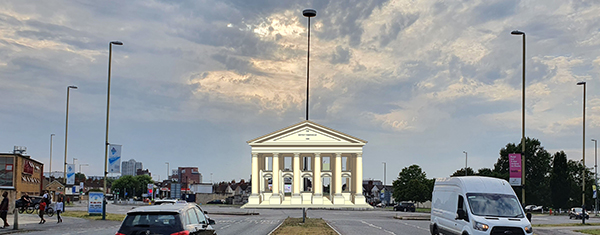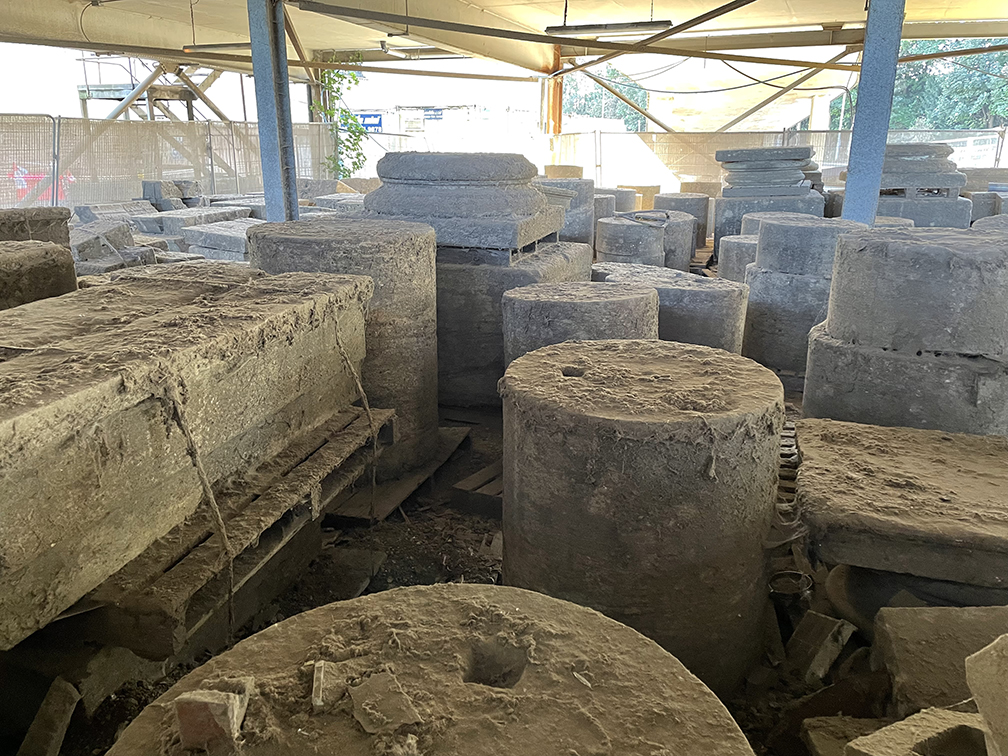Swindon in Wiltshire is faced with a dilemma: what to do with the stones of a Victorian Romano Classical portico from the town’s Baptist Tabernacle that was taken down more than 40 years ago.
The stones of the portico are currently languishing under a ramp in a refuse recycling yard, but whenever someone suggests a way of rebuilding the portico, others seem to object to it.
The latest proposal is that the portico should front a new art gallery in the town and a website is proposed to ascertain public opinion.
The story of the Bath stones of the portico goes back to 1978, when Sir John Betjeman, Nikolaus Pevsner and the Victorian Society petitioned the Department of the Environment to prevent the demolition of the stone-built temple erected in 1886 as the Baptist Tabernacle in Swindon, Wiltshire. Sir John Betjeman said the building was as important to Swindon as St Martin in the Fields is to London.
However, the Secretary of State at the time, Labour’s Peter Shore, decided not to intervene and the Tabernacle was demolished to make-way for a mixed use development incorporating a new smaller Baptist church known as the Pilgrim Centre. But the stone of the Portico was dismantled and sold.
It was originally going to be rebuilt as the front of a grand mansion being proposed at that time, but planning permission for that house could not be obtained. The stones were sold on to another wealthy individual who also intended to build a mansion but, again, planning permission was refused. The stones were eventually purchased by Swindon Borough Council in 2006.
In 2008 it was proposed that the portico should be rebuilt on a site adjacent to its original location as a feature of an art gallery that was a Section 106 condition of a new shopping centre, the Modus, that was being developed. But in 2009, as the full effects of the credit crunch banking crisis started to be felt, Modus Swindon Ltd was put into receivership and the shopping centre scheme shelved.
Swindon Borough Council continues to moot ideas for the re-use of the Portico, but without a strategy based on conservation principles, such schemes are unlikely to succeed or stand-up to scrutiny, says Michael Gray, BA(Hons)(ARCH)Dip Arch RIBA, who has written a dissertation about the stones of the portico for a Masters Degree in the Conservation of Historic Buildings he is working towards.
He says he is currently in consultation with Swindon Council’s Head of Culture & Heritage about using the stones, which have an historical and cultural value to the town.
In his Masters thesis Michael Gray describes the history and detail of the Tabernacle Portico and reviews the relevance of current conservation charters to it. He examines the Modus approach and a subsequent proposal to rebuild the portico in the Lawn, a public park in Swindon. It is a proposal he supports.
Today the Lawn is mainly used for dog walking and a cut-through for cyclists, but in his Masters paper Michael Gray says it is unfortunate that one of the most significant historical sites in Swindon, which dates back to the Bronze Age, is now neglected and under-used. He says to site the portico on the eastern terrace of the Lawn would bring renewed interest to the park and could form a focus for rejuvenation.
He writes: “By making the Portico an independent structure here minimises the likelihood of historical uncertainty and reinstates the portico as an important piece of architecture on the Swindon skyline.”
He says Monopoly recently promoted its popular board game by producing a Swindon edition, in which it substituted traditional London place names in its original game for Swindon equivalents. Mayfair was swapped for ‘the magic roundabout’, a notorious local traffic junction in Swindon.
Michael says: “Although the roundabout substitution was a bit tongue-in-cheek, it disguises the fact that there is no clear alternative for the Mayfair spot in Swindon. I suggest that a reconstructed tabernacle portico on the eastern terrace of the Lawn would be that replacement, being once again a building of significance and importance to the town of Swindon.”
Michael told Natural Stone Specialist magazine that rebuilding the Tabernacle portico would cost at least £1million, probably more. Each column would have been hand-made, so identifying the right stones in the right order for the rebuilding of each column would require some effort.
He says he would like to see the portico fronting a new art gallery and museum, as an existing building used for the purpose that was closed by Covid is not in good condition.


